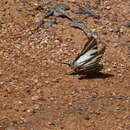pms
nòm ant ël fil


Protographium leosthenes, the four-barred swordtail, is a medium-sized butterfly of the family Papilionidae found in Australia. It is similar to the five-barred (or chain) swordtail (Graphium aristeus) found in both Australia and India.[1]
Adults are brown and white, with four brown parallel bars running down the leading edge of the forewing. The hindwings have a pointed tail. Their wingspan is approximately 49 mm for males and 53 mm for females.[2][3] The four-barred swordtail can be distinguished from the five-barred swordtail by the number of bars, and pale orange and blue spots on the upperside of the hindwing. In addition, the four-barred swordtail has pale orange markings on the underside of its hindwing, rather than red markings.[3]
The eggs are cream coloured and laid singly on young leaves of the larval plant.[4] The larvae feed on Melodorum leichhardtii, Melodorum rupestre, Polyalthia nitidissima and occasionally Desmos wardianus.[3][4] Early instars are pale green, with black spots and a black thorax and tail. The caterpillar later becomes green with brown or yellow spots, and reaches a length of up to 3.5 centimetres.[4] The pupa is about 2 centimetres in length, and green with pink markings.[4] There is usually one generation per year, with adult emergence varying with the season.[3]
The preferred habitat is monsoon forest and subtropical rainforest, where the larval plants are found.[3] Adults fly near the ground (within about 2 metres) with their wings spread.[3] The males frequently hilltop.
Protographium leosthenes, the four-barred swordtail, is a medium-sized butterfly of the family Papilionidae found in Australia. It is similar to the five-barred (or chain) swordtail (Graphium aristeus) found in both Australia and India.
Protographium leosthenes ou Eurytides epidaus est un insecte lépidoptère de la famille des Papilionidae, de la sous-famille des Papilioninae et du genre Protographium.
Il a été décrit par Henry Doubleday en 1846 sous le nom initial de Papilio leosthenes[1].
Protographium leosthenes se nomme Four-bar Swordtail en anglais[1].
Protographium leosthenes est un papillon d'une envergure d'environ 49 mm, (53 mm pour les mâles, 50 mm pour les femelles, de forme triangulaire avec une très longue queue à chaque aile postérieure[2],[3]. Il est blanc rayé de marron avec aux ailes antérieures quatre bandes marron qui partent du bord costal. Les ailes postérieures à bord externe festonné sont bordées de noirs avec des chevrons blancs et bleu pour les deux plus proches de l'angle anal et la queue est noire bordée de blanc.
L’œuf est rond et de couleur crème. La chenille à ses premiers stades est vert pâle à petits points blancs[2].
Les plantes hôtes de sa chenille sont des Annonaceae, Melodorum leichhardti, Melodorum rupestrum, Melodorum uhrii, Rauwenhoffia leichhardtii et Desmos wardianus[1].
Protographium leosthenes réside dans l'est de Australie[1].
Pas de statut de protection particulier.
Protographium leosthenes ou Eurytides epidaus est un insecte lépidoptère de la famille des Papilionidae, de la sous-famille des Papilioninae et du genre Protographium.
Protographium leosthenes is een vlinder uit de familie van de pages (Papilionidae).[1] De wetenschappelijke naam van de soort is voor het eerst geldig gepubliceerd in 1846 door Edward Doubleday.
Bronnen, noten en/of referenties